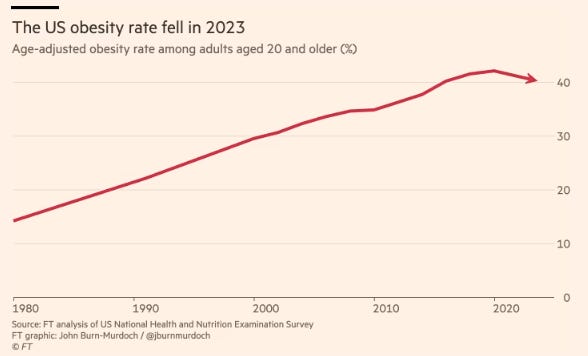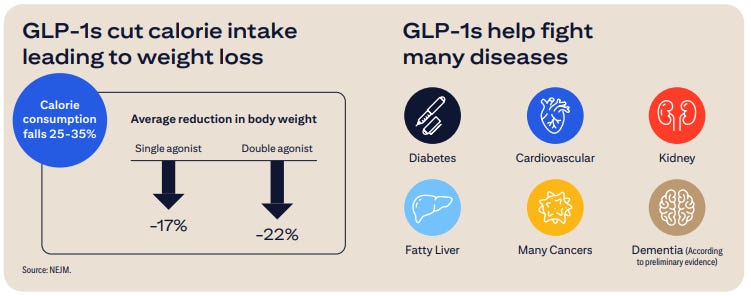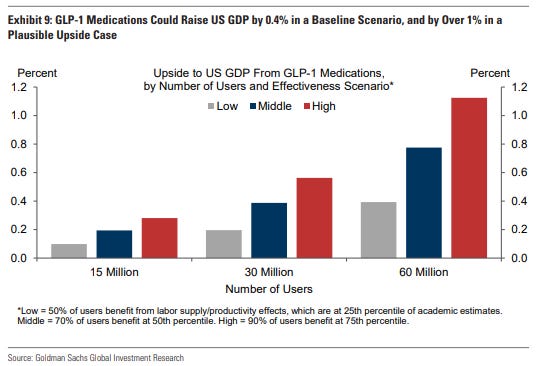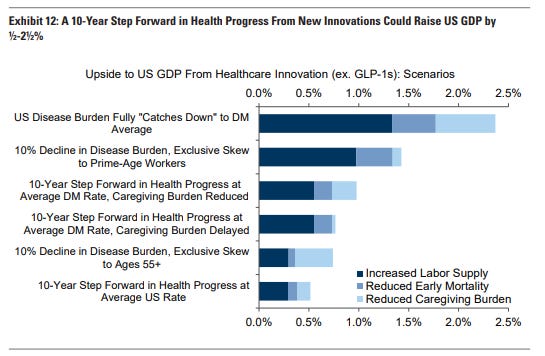It could be argued — quite fairly! — that this newsletter spends slightly too much time discussing and analyzing recent developments in artificial intelligence and their potential impact on the American economy. That, at least, versus what's been happening with GLP-1 receptor agonists: weight-loss drugs such as Ozempic and Wegovy. The GLP-1 agonists, according to a new big piece in The Economist, may well become the next watershed moment in pharmaceutical history. Just as Humira revolutionized rheumatoid arthritis treatment, Prozac transformed mental health care, and statins redefined cardiovascular medicine, these drugs are poised to make their own historic impact.
From the story: “All have helped patients far beyond doctors’ initial expectations and continue to benefit millions of people every day.”
The Financial Times has even gone so far as to declare America may have arrived at “Peak Obesity” as demonstrated in this chart, thanks to these medications:
I certainly think its plausible to say that GLP-1 drugs may, at this moment, be a more important innovation than generative AI. Just as GenAI is looking like a general-purpose technology that can help businesses across the economy, GLP-1s are looking like a general-purpose wonder drug. Their impact extends beyond weight loss. Clinical trials have shown they slow the progression of several chronic diseases, including cardiovascular, kidney, and fatty liver diseases. In overweight individuals, tirzepatide specifically has been shown to reduce diabetes risk by over 90 percent. Early research suggests these drugs may help slow Alzheimer's development. User reports and preliminary studies also indicate they may also reduce addictive behaviors around alcohol and nicotine, though the mechanisms behind these effects are still being investigated.
Again, The Economist: “Few drugs, if any, have promised to have such a revolutionary impact on human health, longevity and happiness.”
Also like GenAI, it’s still early days when trying to figure out the economic impact of this still-improving innovation. As a new Citigroup report (the source of the previous two graphics) notes, there are more than a hundred new GLP-1 drugs in the pipeline that aim to be more convenient (as pills rather than injections), reduce side effects like nausea and muscle loss, or simply provide better weight-loss results.
Still, we can take our best shot. Citi estimates that GLP-1 drugs could boost GDP by 0.5 percent to one percent in rich countries. The bank reaches this conclusion by starting with OECD estimates that obesity reduces labor force output by approximately two percent in developed countries. It then assumes GLP-1s could reclaim about half of this impact by reducing obesity-related health issues and increasing labor force participation among people in late middle age.
Citi: “In a scenario where GLP-1s benefit a large number of people, there could be a gradual increase in the available labor force … due to reduction in musculoskeletal issues and chronic diseases, boosting both GDP and tax revenue.”
What’s more, a Goldman Sachs analysis from earlier this year estimates that GLP-1 drugs could boost GDP by 0.4 percent in its baseline scenario, with potential gains up to one percent in its upside case. They derive these figures by starting with academic research showing obesity reduces output by three percent per capita, split between a 1.2 percent reduction in labor force participation and a 1.9 percent decline in productivity. GS then multiplies these impacts by their projected number of GLP-1 users (30 million in baseline, up to 60 million) and expected effectiveness rates (70 percent in baseline, up to 90 percent).
Bottom line: Both papers point to an impact in the ballpark of 0.5 to one percent of GDP in their main scenarios. Not too shabby.
By the way, GS also tries to guesstimate the impact of other health innovations, and calculate a combined impact with obesity drugs:
… advances in computational biology, the advent of big data in healthcare, and a greater understanding of human genomics (via the Human Genome Project and a lower cost of sequencing)—which have spurred innovations in areas such as AI-powered drug discovery, gene editing, improved immunotherapy, better diagnostics, and the development of more affordable biosimilar drugs—could accelerate health improvements. While it is difficult to take a stance on the timing with which individual therapies will cross specific regulatory, cost, and adoption thresholds, the totality of innovation progress in these areas could drive an acceleration in the pace of health progress. … Given the largely indeterminate effects of healthcare innovation on fiscal budgets and inflation but potentially significant GDP upside from GLP-1s and data-driven innovations, we expect ongoing health innovation to impact the economy most clearly through higher output. .. . Overall, we estimate that the current wave of healthcare innovation could raise the level of US GDP in excess of trend by 1.3% in the coming years (equivalent to $360bn per year in today’s dollars) with plausible effects ranging from 0.6 to 3.2%.
I’m excited about the potential economic impact of GenAI, but for now we should still assume the American economy is a Two Percent Economy, even though it’s been doing better than that. Under that assumption, the economic benefits of GLP-1 drugs are substantial. Obviously, the health benefits, too.
Consider: While medical advances can result in improved labor productivity and longer working lives, many major health improvements that enhance human welfare (like more leisure time and increased life expectancy) aren't captured in traditional productivity statistics since they occur outside of market transactions, the Congressional Budget Office has noted.
For example: “Life expectancy gains continued steadily in the latter 20th century even as measured [total factor productivity] growth slowed, suggesting standard economic metrics may understate the true impact of health innovation on human wellbeing.” Likewise, the GS analysis explicitly notes that "GDP is a poor proxy for the societal value of healthcare innovation" because it misses many quality-of-life benefits.
And for GLP-1s, those benefits seem myriad.
James Pethokoukis is a fellow at the American Enterprise Institute and an official CNBC contributor.
https://fasterplease.substack.com/p/will-the-anti-obesity-wonder-drugs








No comments:
Post a Comment
Note: Only a member of this blog may post a comment.